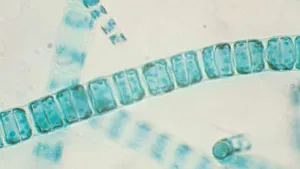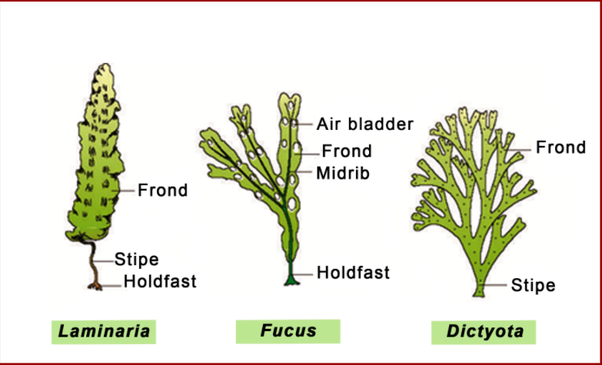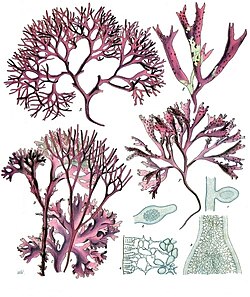ALGAE (FATHER OF ALGOLOGY:F.E FRITSCH)
-Algae are chlorophyll containing, simple, thalloid (plant body not differentiated into root, stem and leaf) and autotrophic organisms.
- Algae reproduction sexually through processes like conjugation, where genetic material is exchanged between two cells,or through the formation of specialized reproductive structure like gametes. This allows for genetic diversity and adaptation in algae populations.
The main characteristics of algae are:-
- Algae are largely aquatic, either marine or fresh water. They also occur in habitats like moist stones, soils and wood. Some of them also occur in association with fungi (lichen) and animals (e.g. on sloth bear).
- Algae are of variable size and forms. The size ranges from the unicellular (chlamydomonas), colonial (Volvox), filamentous kelps to massive plant bodies (Ulothrix and Spirogyra).
- Vascular tissue are absent.
- Algae reproduce by vegetative, asexual and sexual methods.
- Vegetative reproduction is by fragmentation. In fragmentation the parent body breaks into two or more fragments which develops into a thallus.
- During the asexual reproduction different types of spores are produced. Spores are released from the parent body which, on germination give rise to new plants. The most common spores produced are the flagellated (motile) zoospores.
- Sex organs are non-jacketed and unicellular. Sexual reproduction can be:-
(i) Isogamous:– Fusion of two gametes which are similar in size, either flagellated or non-flagellated is termed as isogamous; Ulothrix (gametes are flagellated and similar in size), Spirogyra (gametes are non-flagellated and similar in size).
(ii) Anisogamous:- Fusion of two gametes which are dissimilar in size is termed as anisogamous. e.g. Eudorina.
(iii) Oogamous:- When a small, motile or non-motile male gamete fuses with a large non-motile female gamete, such type of reproduction is known as oogamous, e.g. Volvox, Fucus, Polysiphonia (both gametes non-motile).
Algae are mainly classified on the basis of their pigments. Flagellation, storage products and chemistry of cell wall a re also taken into account. The three classes of algae are Chlorophyceae (greenalgae), Phaephyceae (brown algae) and Rhodophyceae (red algae).
CHLOROPHYCEAE (GREEN ALGAE)
- The pigments, chlorophyll-a, chlorophyll-b carotene and xanthophyll are present in them. They are usually grass green in colour due to the dominance of pigments, i.e., chlorophyll a and b.
- These pigments are present in definite chloroplasts. The shape of chloroplast varies in different species. It can be discoid , plate-like reticulate, cup-shaped, spiral or ribbon-shaped.
- The plant body may be unicellular , colonial or flamentous.
- Most of the green algae have one or more storage bodies called pyrenoids located in the chloroplasts. Pyrenoids contain protein and starch . In some food is stored in the form of oil droplets.
- Green algae usually have a rigid cell wall made up of inner layer of cellulose and an outer layer of pectose.
- Vegetative reproduction by fragmentation.
- Asexual reproduction takes place by zoospores produced inside the zoosporangia. Zoospores have 2-8, apically inserted isokont flagella.
- Sexual reproduction may be isogamous, anisogamous or oogamous.
- Some commonly found green algae are:- Chlamydomonas, Volvox, Ulothrix, Spirogyra and Chara.

PHAEOPHYCEAE (BROWN ALGAE)
- Brown algae are found primarily in marine habitats.
- They possess the pigment chlorophyll a and c, carotenoids and xanthophylls.
- They vary in colour from olive green to various shades of brown depending upon the amount of the xanthophyll called fucoxanthin.
- They show great variationof size and form. In Ectocarpus the body is simple branched and filamentous whereas in kelps the body is profusely branched e.g. Laminaria, Macrocystis. Kelps may reach a height of 100 meters.
- Food is stored as complex carbohydrates which may be in the form of laminarin or mannitol (alcoholic sugar).
- Brown algae have cell wall made up of cellulose which is ususall covered on the outside by a gelatinous coating of algin (Algin is a hydrocolioid which has good water holding capacity).
- Their protoplast contains plastids, a centrally located vacuole and nucleus.
- The plant body is often differentiated into holdfast for attachment to a substratum, stipe (stalk) and leaf-like photosynthetic organ called frond.
- The large forms often possess air bladders for providing buoyancy.
- Vegetative reproduction takes place by fragmentation.
- Asexual reproduction occurs with the help of biflagellate that are pear-shaped and have two unequal laterally attached flagella.
- Sexual reproduction may be isogamous, anisogamous or oogamous. Fusion of gametes takes place in water but in oogamous species fuse in the oognium. Oogonium is the female reproductive structure, usually a rounded cell or sac containing egg cell or oosphere (thenon-motile female gamete).
- The gamete are pyriform i.e. pear-shaped and bear two laterally attached flagella.
- The common forms of brown algae are Ectocarpus, Dictyota, Laminaria, Sar gassum and Fucus

RHODOPHYCEAE (RED ALGAE)
- The pigments present in them are r-phycoerythrin, r-phycocyanin, chlorophyll-a and chlorophyll-d. The characteristic red colour is due to the predominance of the red pigment, r-phycoerythrin.
- They are mostly found in marine habitats with abundance in the warmer areas.
- They occur in both well-lighted regions close to the surface of water and also at regions where relatively little light penetrations, i.e. at great depths in oceans.
- Most of the red algae are multicellular. Some of them have complex body organisation.
- Cell wall is composed of cellulose, pectin and hydrocolloids like agar, carrageen and funori (hydrocolloids).
- Food is stored in the form of floridean starch. Structurally, it is very similar to amylopectin and glycogen.
- They reproduce vegetatively by fragmentation.
- Red algae reproduce asexually by non-motile spores.
- Sexual reproduction is oogamous and the gametes are non-motile.
- Complex, post-fertlilisation developments occur.
- The common members are:- Polysiphonia, Porphyra, gracilaria and Gelidium.
Note:-
+ red algae can reach the maximum depth in see where no other photosynthetic forms grow. They contain phycoerythrin pigment which can absorb blue-green part sunlight spectrum which can penetrate deep into the water.

ECONOMIC IMPORTANCE OF ALGAE
(I) Photosynthesis:- At least a half of the total carbon dioxide fixation on earth is carried out by algae through photosynthesis.
(ii) Primary Producers:- Algae are primary producers of energy-rich compounds (food). This form the basis of food cycles of all aquatic animals.
(iii) Food supplements:- Many species of porphyra (Red algae). Laminaria and Sargassum (Brown algae) are among the 70 species of marine algae used as food. Certain unicellular algae like Chlorella and Spirullina are rich in proteins and are used as food supplements even by space travellers.
(iv) Hydrocolloids:- Hydrocolloids are water-holding substances. Algin and carrageen are hydrocolloids obtained from brown and red algae, respectively. Agar (a hydrocolloid) is one of the commercial products obtained from Gelidium and Gracilaria and are used to grow microbes and in preparations of ice-creams and jellies.
(v) Iodine:- Fucus and Laminaria are sources of iodine
FUN FACTS:-
Diverse Habitat: Algae can be found in almost every habitat on Earth, from oceans and freshwater lakes to snowfields and even inside rocks. They are incredibly adaptable and can thrive in extreme environments such as hot springs and polar regions.
Oxygen Producers: Algae are one of the primary producers of oxygen on Earth. Through photosynthesis, algae convert carbon dioxide and sunlight into oxygen and organic compounds, playing a crucial role in maintaining the planet’s atmospheric balance.
Ancient Organisms: Algae are among the oldest living organisms on Earth, with fossils dating back over 3 billion years. They played a significant role in shaping Earth’s early atmosphere and providing the foundation for complex life forms to evolve.
Bioluminescence: Some species of algae exhibit bioluminescence, meaning they can emit light through a chemical reaction within their cells. This light production serves various purposes, including defense against predators, attracting mates, and signaling.
Nutritional Powerhouses: Algae are rich sources of essential nutrients, including vitamins, minerals, proteins, and omega-3 fatty acids. They are consumed by humans and animals worldwide and are valued for their nutritional benefits and potential health properties.
Biofuel Potential: Certain species of algae have attracted attention as a promising source of biofuel. Algae can produce high yields of oils that can be converted into biodiesel or other biofuels, offering a sustainable alternative to fossil fuels.
Natural Dyes: Algae have been used for centuries to produce natural dyes for textiles and art. Different species of algae produce a wide range of vibrant colors, including greens, blues, reds, and browns, which can be extracted and used for dyeing fabrics.
Indicator Species: Algae are excellent indicators of environmental health. Changes in algal populations, such as the proliferation of harmful algal blooms (HABs), can signal pollution, nutrient imbalances, or other environmental disturbances in aquatic ecosystems.
Algal Blooms: While algae are essential components of healthy ecosystems, excessive growth of certain algae can lead to harmful algal blooms (HABs). These blooms can produce toxins harmful to aquatic life and human health and can cause ecological and economic damage.
Artistic Inspiration: Algae have inspired artists, scientists, and designers alike with their diverse forms, colors, and patterns. From intricate microscopic structures to vast underwater forests, algae continue to captivate and inspire creativity in various fields.
Algae are a diverse group of photosynthetic organisms that can be found in various aquatic environments, including oceans, lakes, rivers, and even damp terrestrial habitats. They range from microscopic unicellular organisms to large multicellular seaweeds.
Algae play a crucial role in aquatic ecosystems as primary producers, converting sunlight into organic matter through photosynthesis. They form the base of the food chain, providing food and oxygen for a wide range of aquatic organisms. Additionally, they contribute to nutrient cycling and help stabilize aquatic habitats.
Yes, algae provide numerous environmental benefits. They play a crucial role in carbon sequestration and oxygen production, helping mitigate climate change and maintain atmospheric balance. Additionally, algae can be used in bioremediation to remove pollutants from water bodies.
In marine ecosystems, algae provide habitat and food for a diverse array of marine organisms, including fish, invertebrates, and marine mammals. They also contribute to the formation of coral reefs and provide essential nutrients for reef-building corals.
Yes, algae are sensitive to environmental changes, including fluctuations in temperature, light intensity, nutrient availability, and water chemistry. Anthropogenic activities such as pollution, habitat destruction, and climate change can impact algal populations and disrupt aquatic ecosystems.